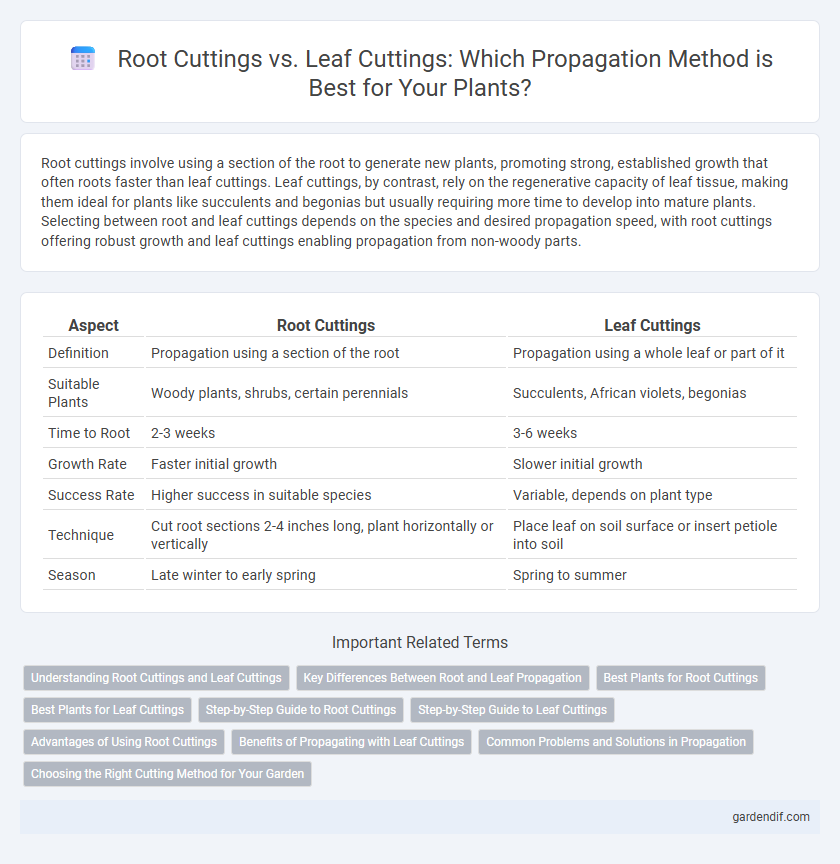
Root Cuttings vs Leaf Cuttings Illustration
Root cuttings involve using a section of the root to generate new plants, promoting strong, established growth that often roots faster than leaf cuttings. Leaf cuttings, by contrast, rely on the regenerative capacity of leaf tissue, making them ideal for plants like succulents and begonias but usually requiring more time to develop into mature plants. Selecting between root and leaf cuttings depends on the species and desired propagation speed, with root cuttings offering robust growth and leaf cuttings enabling propagation from non-woody parts.
Table of Comparison
| Aspect | Root Cuttings | Leaf Cuttings |
|---|---|---|
| Definition | Propagation using a section of the root | Propagation using a whole leaf or part of it |
| Suitable Plants | Woody plants, shrubs, certain perennials | Succulents, African violets, begonias |
| Time to Root | 2-3 weeks | 3-6 weeks |
| Growth Rate | Faster initial growth | Slower initial growth |
| Success Rate | Higher success in suitable species | Variable, depends on plant type |
| Technique | Cut root sections 2-4 inches long, plant horizontally or vertically | Place leaf on soil surface or insert petiole into soil |
| Season | Late winter to early spring | Spring to summer |
Understanding Root Cuttings and Leaf Cuttings
Root cuttings involve the use of sections of roots from a parent plant to generate new growth, ensuring genetic consistency and often resulting in faster establishment compared to leaf cuttings. Leaf cuttings require parts of leaves, sometimes including the petiole, to develop new plants, typically used for species that can regenerate from leaf tissue, such as African violets or begonias. Understanding the differences in tissue type, regeneration process, and species suitability between root and leaf cuttings is essential for effective propagation and maximizing plant survival rates.
Key Differences Between Root and Leaf Propagation
Root cuttings involve using sections of roots to generate new plants, resulting in clones often more robust than those from leaf cuttings. Leaf cuttings depend on the leaf tissue's ability to develop roots and shoots, making them effective for certain species like succulents but less reliable for others. The primary difference lies in the plant part used and the subsequent growth process, affecting propagation success rates and plant resilience.
Best Plants for Root Cuttings
Root cuttings are ideal for plants with robust root systems, such as blackberries, horseradish, and gooseberries, enabling efficient propagation of genetically identical offspring. These cuttings thrive because they develop new shoots directly from the root system, ensuring rapid establishment and growth. Compared to leaf cuttings, root cuttings typically yield higher success rates for woody plants and perennials that are less amenable to leaf propagation methods.
Best Plants for Leaf Cuttings
Leaf cuttings are best suited for propagating plants like African violets, begonias, and succulents such as jade plants, as these species readily develop roots and new shoots from leaf tissue. Unlike root cuttings, which primarily work for woody or herbaceous plants like horseradish and raspberries, leaf cuttings enable faster and more efficient multiplication of certain ornamental and houseplants. Leaf cuttings typically require high humidity and indirect light to promote successful root formation and healthy growth.
Step-by-Step Guide to Root Cuttings
Root cuttings involve selecting healthy, mature roots typically 1/4 to 1/2 inch thick, which are then cut into 2-4 inch segments to encourage new shoots. These segments should be placed horizontally or vertically in moist, well-draining soil, covered lightly, and kept at a consistent temperature of 65-75degF to promote root development. Regular monitoring for moisture and signs of sprouting ensures successful propagation through root cuttings.
Step-by-Step Guide to Leaf Cuttings
Leaf cuttings propagation involves selecting healthy leaves, carefully excising them with a sterile blade, and then placing them on a moist, well-draining growing medium like a mix of peat and perlite. Maintaining high humidity and indirect light encourages root and shoot development from the leaf base over several weeks. Regular misting ensures the medium stays moist without waterlogging, promoting successful new plant growth from leaf cuttings.
Advantages of Using Root Cuttings
Root cuttings offer a higher success rate in propagation due to their direct access to stored nutrients and inherent growth hormones, facilitating robust plant development. This method ensures genetic consistency, producing clones identical to the parent plant, which is essential for maintaining desirable traits in horticulture. Root cuttings also bypass the vulnerable seedling stage, reducing susceptibility to environmental stress and diseases.
Benefits of Propagating with Leaf Cuttings
Propagating with leaf cuttings offers higher success rates for many plant species due to their ability to develop both roots and shoots from a single leaf structure. This method accelerates the growth cycle by producing multiple new plants rapidly without the need for extensive root systems. Leaf cuttings also reduce the risk of soil-borne diseases since they require minimal soil contact compared to root cuttings.
Common Problems and Solutions in Propagation
Root cuttings often face issues like rot due to excessive moisture, while leaf cuttings commonly suffer from desiccation and fungal infections. Maintaining well-drained soil and moderate humidity levels can prevent root rot in root cuttings, whereas using a fungicide and ensuring proper ventilation reduces fungal problems in leaf cuttings. Applying a rooting hormone enhances success rates by promoting faster and healthier root development in both propagation methods.
Choosing the Right Cutting Method for Your Garden
Root cuttings provide a dependable way to propagate woody plants with well-established root systems, ensuring strong and healthy new growth. Leaf cuttings suit succulent and herbaceous plants, promoting faster rooting and a higher chance of success with species like African violets and begonias. Selecting the appropriate cutting method depends on the plant type, desired growth rate, and garden conditions to maximize propagation success.
Root Cuttings vs Leaf Cuttings Infographic

 gardendif.com
gardendif.com